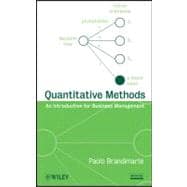
What is included with this book?
Part I. Motivations and Foundations.
1 Quantitative Methods: Should we Bother?.
1.1 A decision problem without uncertainty: product mix.
1.2 The role of uncertainty.
1.3 Endogenous vs. exogenous uncertainty: Are we alone?.
1.4 Quantitative models and methods.
1.5 Quantitative analysis and problem solving.
Problems.
For further reading.
References.
2 Calculus.
2.1 A motivating example: economic order quantity.
2.2 A little background.
2.3 Functions.
2.4 Continuous functions.
2.5 Composite functions.
2.6 Inverse functions.
2.7 Derivatives.
2.8 Rules for calculating derivatives.
2.9 Using derivatives for graphing functions.
2.10 Higher-order derivatives and Taylor expansions.
2.11 Convexity and optimization.
2.12 Sequences and series.
Problems.
For further reading.
References.
3 Linear Algebra.
3.1 A motivating example: binomial option pricing.
3.2 Solving systems of linear equations.
3.3 Vector algebra.
3.4 Matrix algebra.
3.5 Linear spaces.
3.6 Determinant.
3.7 Eigenvalues and eigenvectors.
3.8 Quadratic forms.
3.9 Calculus in multiple dimensions.
Problems.
For further reading.
References.
Part II Elementary Probability and Statistics.
4 Descriptive Statistics: On the Way to Elementary Probability.
4.1 What is Statistics?.
4.2 Organizing and representing raw data.
4.3 Summary measures.
4.4 Cumulative frequencies and percentiles.
4.5 Multidimensional data.
Problems.
For further reading.
References.
5 Probability Theories.
5.1 Different concepts of probability.
5.2 The axiomatic approach.
5.3 Conditional probability and independence.
5.4 Total probability and Bayes’ theorems.
Problems.
For further reading.
References.
6 Discrete Random Variables.
6.1 Random variables.
6.2 Characterizing discrete distributions.
6.3 Expected value.
6.4 Variance and standard deviation.
Problems.
For further reading.
References.
7 Continuous Random Variables.
7.1 Building intuition: from discrete to continuous random variables.
7.2 Cumulative distribution and probability density functions.
7.3 Expected value and variance.
7.4 Mode, median, and quantiles.
7.5 Higher-order moments, skewness, and kurtosis.
7.6 A few useful continuous probability distributions.
7.7 Sums of independent random variables.
7.8 Miscellaneous applications.
7.9 Stochastic processes.
7.10 Probability spaces, measurability, and information.
Problems.
For further reading.
References.
8 Dependence, Correlation, and Conditional Expectation.
8.1 Joint and marginal distributions.
8.2 Independent random variables.
8.3 Covariance and correlation.
8.4 Jointly normal variables.
8.5 Conditional expectation.
Problems.
For further reading.
References.
9 Inferential Statistics.
9.1 Random samples and sample statistics.
9.2 Confidence intervals.
9.3 Hypothesis testing.
9.4 Beyond the mean of one population.
9.5 Checking the fit of hypothetical distributions: the chi-square test.
9.6 Analysis of variance.
9.7 Monte Carlo simulation.
9.8 Stochastic convergence and the law of large numbers.
9.9 Parameter estimation.
9.10 Some more hypothesis testing theory.
Problems.
For further reading.
References.
10 Simple Linear Regression.
10.1 Least squares method.
10.2 The need for a statistical framework.
10.3 The case of a non-stochastic regressor.
10.4 Using regression models.
10.5 A glimpse of stochastic regressors and heteroskedastic errors.
10.6 A vector space look at linear regression.
Problems.
For further reading.
References.
11 Time Series Models.
11.1 Before we start: Framing the forecasting process.
11.2 Measuring forecasting errors.
11.3 Time series decomposition.
11.4 Moving average.
11.5 Heuristic exponential smoothing.
11.6 A glance at advanced time series modeling.
Problems.
For further reading.
References.
Part III Models for Decision Making.
12 Deterministic Decision Models.
12.1 A taxonomy of optimization models.
12.2 Building linear programming models.
12.3 A repertoire of model formulation tricks.
12.4 Building integer programming models.
12.5 Nonlinear programming concepts.
12.6 A glance at solution methods.
Problems.
For further reading.
References.
13 Decision Making under Risk.
13.1 Decision trees.
13.2 Risk aversion and risk measures.
13.3 Two-stage stochastic programming models.
13.4 Multi-stage stochastic linear programming with recourse.
13.5 Robustness, regret, and disappointment.
Problems.
For further reading.
References.
14 Multiple Decision Makers, Subjective Probability, and Other Wild Beasts.
14.1 What is uncertainty?.
14.2 Decision problems with multiple decision makers.
14.3 Incentive misalignment in supply chain management.
14.4 Game theory.
14.5 Braess' paradox for traffic networks.
14.6 Dynamic feedback effects and herding behavior.
14.7 Subjective probability: the Bayesian view.
Problems.
For further reading.
References.
Part IV Advanced Statistical Modeling.
15 Introduction to Multivariate Analysis.
15.1 Issues in multivariate analysis.
15.2 An overview of multivariate methods.
15.3 Matrix algebra and multivariate analysis.
For further reading.
References.
16 Advanced Regression Models.
16.1 Multiple linear regression by least squares.
16.2 Building, testing, and using multiple linear regression models.
16.3 Logistic regression.
16.4 A glance at nonlinear regression.
Problems.
For further reading.
References.
17 Dealing with Complexity: Data Reduction and Clustering.
17.1 The need for data reduction.
17.2 Principal component analysis (PCA).
17.3 Factor analysis.
17.4 Cluster analysis.
For further reading.
References.
Index.
The New copy of this book will include any supplemental materials advertised. Please check the title of the book to determine if it should include any access cards, study guides, lab manuals, CDs, etc.
The Used, Rental and eBook copies of this book are not guaranteed to include any supplemental materials. Typically, only the book itself is included. This is true even if the title states it includes any access cards, study guides, lab manuals, CDs, etc.